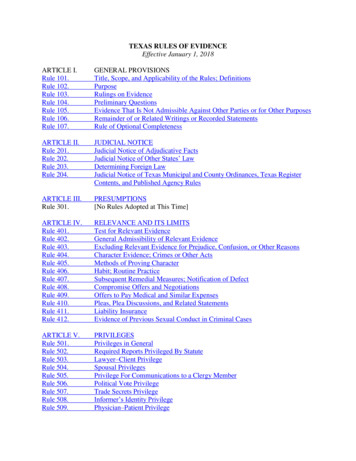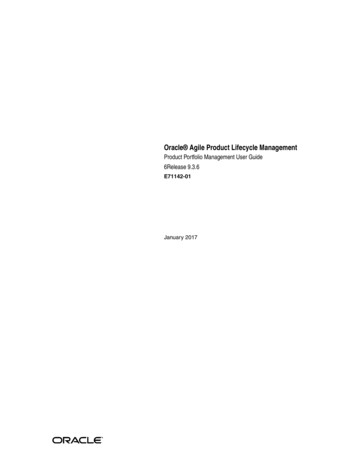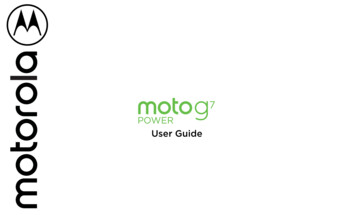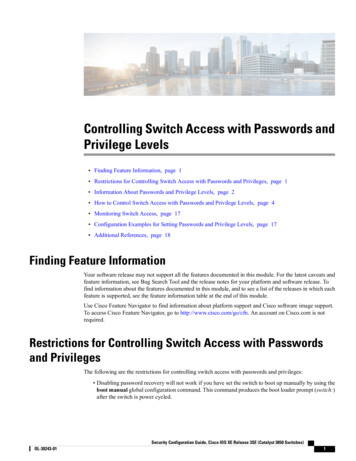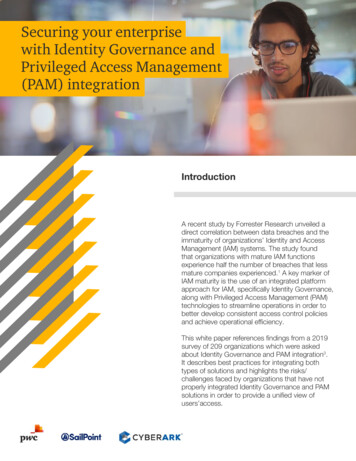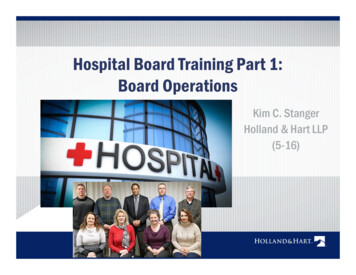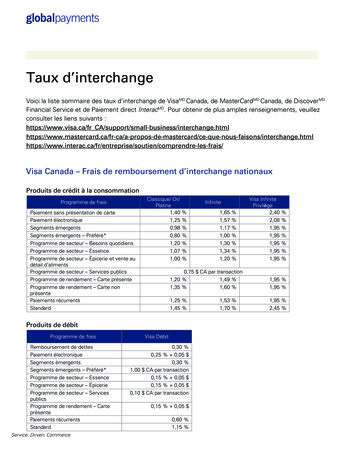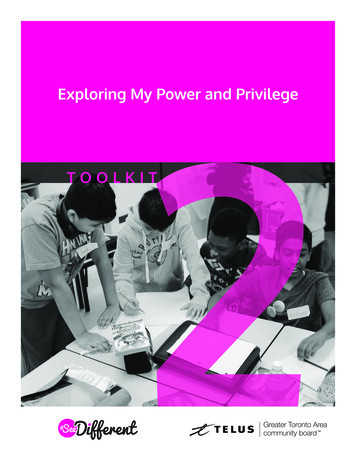
Transcription
Exploring My Power and PrivilegeTOOLKIT
AcknowledgmentsWe would like to thank the TELUS Greater Toronto Area CommunityBoard for their generous contribution in supporting the developmentof this toolkit.We would also like to thank the members of our See DifferentAdvisory Committee who have been instrumental in the success ofthis program and the development of this toolkit: Cecil Roach, Coordinating Superintendent of Equity andCommunity Services, York District School Board Danny DiLallo, Vice-Principal, York Catholic DistrictSchool Board Laura Proctor, OCT Maria Papadimitriou, MSc., MPH, CTDP Thomas Sasso, MA, PhD Candidate, University of Guelph W. Y. Alice Chan, PhD Candidate, McGill UniversityArt Direction and Graphic Design Calleja DesignCover Students from The Woodlands School (Peel District School Board)Authors Preeti Nayak, M.Phil and Pam Malins, PhDContributor Yara Kodershah, M.EdEditor Wanda Santini, PhDCopyright 2017 Canadian Centre for Diversity and Inclusion.All rights reserved. You may link to this document on our website,download it for personal use, or use a quote only if you includeattribution and the page URL. If you intend to refer to it in anotherpublication, please request permission at communications@ccdi.caSee Different PrefaceAcknowledgments 2
Table of ContentsPREFACEAcknowledgments 2Introduction to the See Different Toolkits 4Teacher and Student Testimonials 5How to use these Toolkits 6TOOLKIT 2: EXPLORING MY POWER AND PRIVILEGE 8Preliminary Readings: Build your Knowledge 9Overview of Toolkit 2 Activities 111 Introductions 122 Equality vs. Equity Classroom Scenarios 133 Paper Basket Exercise 164 Power Flower 195 Walking the Talk: Introduction to Social Movements 226 Wrap-Up 24Facilitator Guides/Handouts 25See Different PrefaceTable of Contents 3
Introduction to the See Different ToolkitsWHAT IS IT?WHY SHOULD I USE IT?These toolkits include classroom orextracurricular programming material tosupport high school students in valuing andembracing diversity and inclusion. Eachtoolkit contains:See Different was a successful high schooldiversity and inclusion training programthat reached over 500 students in fiveschool boards2 in Ontario. Its activities weredeveloped and revised based on positivecomprehensive feedback from teachersand students alike. Today, the programhas been transformed into these toolkits,with the intention of supporting teachers intheir efforts to build a safer school climate.Through these toolkits, See Differentcontinues to be a strong contributor tothe Canadian classroom. The toolkits helpusers apply equity and inclusion strategies3and connect to the following subject areas:Canadian and World Studies, English,Guidance and Career Education, Arts, andSocial Sciences and Humanities. We inviteall educators to bring See Different intotheir schools. professional development learningresources a facilitator manual for each activity student handouts, and a corresponding PowerPointpresentation that includesembedded multi-media resources(e.g. videos, images).Our toolkits cover the following topics: diversity identity power privilege allyship equality vs. equity conflict mediation leadership cross-cultural communication and social action.The curriculum is a combination ofactivities that have been adapted fromexisting public resources along with originalcontent created by diversity consultantsfrom the Canadian Centre for Diversity andInclusion (CCDI)1.1 CCDI is the parent organization of See Different.See Different Preface2 See Different operated in the following school boards:Toronto Catholic District School Board (TCDSB), PeelDistrict School Board (PDSB), Durham Catholic DistrictSchool Board (DCDSB), York Regional District SchoolBoard (YRDSB) and York Catholic District SchoolBoard (YCDSB)3 For example, Ontario’s Equity and Inclusive EducationStrategy (2009).Introduction 4
TestimonialsI loved how students were able to talk about issues that they usuallyfeel they should be quiet about. The workshops helped students reallyunderstand who they are and the influences around them. Participantswould tell me they think that it should be mandatory for all students to gothrough the See Different program.Nadine Cooper, Teacher North Park S.S, Peel District School BoardI now understand different privileges Ihold in society and it has caused me tosee things differently.See Different student participantI appreciated the paper basket exercise as itallowed the students to become aware of theirprivilege and how they have a responsibilityto use it in order to advocate for those wholack it.Catia Minardi, Teacher St.Mary C.S.S, Durham CatholicDistrict School BoardSee Different PrefaceTestimonials 5
How to use these Toolkits12Build your knowledge of diversity and inclusion We highlyrecommend that teachers review the preliminary resources of each toolkit beforedelivering the workshop. A knowledgeable facilitator is needed to guide richdiscussions with students.Determine mode of delivery See Different can be delivered in several ways. It canbe run as an extracurricular club, as a program integrated into a course, a stand-aloneworkshop, or you can simply pick and choose activities that you deem relevant forother contexts (e.g. team-building exercise for a sports team, student retreat program,etc.). Please note the concepts covered in Workshops 1 – 5 build on each other andincrease in complexity. If you plan on delivering the full workshops, we recommenddelivering the program in chronological order. The Master Toolkit is a compilation ofWorkshops 1 – 5. Below are a few logistical notes we invite you to consider dependingon your mode of delivery: If you choose to integrate the program into your course, we recommend thatSee Different activities not be formally tested or evaluated1 to encourage more activeand authentic student participation. Rather, use these activities as complementarymaterials to your core programming and encourage students to reflect on the workthat they do as they progress through the workshops. If you choose to run See Different as an extracurricular club, be aware theseworkshops are a lengthy commitment for students (average 1.5 - 2 hours each).We recommend offering an incentive (e.g. food, swag) so that you have regularparticipation and attendance.3Customize the curriculum content From our experience, we know that no twoschools are alike. Schools each have specific challenges when it comes to building asafe climate. Regardless of which mode of delivery you choose, we invite teachers tocustomize activities in this toolkit to ensure the curriculum highlights local diversity andinclusion issues that pertain to your specific school communities2. Taking the extra stepto customize the curriculum will allow you to create an optimal learning experience thatresonates with your students. See below for an example of curriculum customization: See Different Toolkit“We now know that our invisible dimensions of identity canimpact our interactions with others. Can someone provide an example of what thiscan look like in school?”1 If you plan to assess the program content in some capacity, we recommend using activities and goals from Toolkit 5, as thisworkshop aims to support students in planning a school-wide project.2 To better understand the local needs of your school, consult your school/school board for any data they may have aboutstudent perceptions of equity, inclusion and safety. If not available, consider developing and distributing an exploratorysurvey to your staff and students to identify specific needs in your school community. See this link from the Ontario Ministryof Education to access a template of a Safe Schools Survey: See Different PrefaceHow to use these Toolkits 6
Customization“We now know that invisible dimensions of identity impact ourinteractions with others. When thinking about our school, how does mental health(local relevant issue), an invisible dimension of identity, impact students’ interactionswith others?”To make this easier for you, throughout our Toolkit we have flagged the activities in which werecommend customization. You will see this icon beside the activity:In addition to content, we encourage educators to customize structure wherever possible,to be inclusive of different learning needs.4Facilitate This toolkit has been designed with user-friendliness in mind. The facilitatormanual outlines step-by-step instructions on how to facilitate each activity. Eachactivity outlines the objective, duration and corresponding PowerPoint slides.We also use this icon to flag activities that may generate a sensitive or controversialdiscussion amongst your students:We invite teachers to be extra mindful and attentive during these activities, as a skilledfacilitator will be needed to maintain a safe space and generate critical discussion.Finally, the following colour-coded prompts are intended to express various componentsof the activity:PREAMBLEThis is the introduction to the activity. It explains the purpose of the subsequent activity.SET-UPSome activities require a specific setup. This section will tell you how you might wish toarrange desks, chairs, group your students, etc.INSTRUCTWritten in the first-person narrative these are the instructions you can use to communicatethe activity to your students.DEBRIEFThis section highlights the key take-aways from the activity.See Different PrefaceHow to use these Toolkits 7
Toolkit 2Exploring My Power and PrivilegeOVERVIEWIn the second See Different workshop,participants will dig deeper by exploringhow their identity is informed byexperiences of power and privilege. Theywill then extend this knowledge to betterunderstand the context of Canada’s majorequity-seeking groups which includeLGBT2sQ people, racialized people,Indigenous Peoples, women and peoplewith disabilities. Students will also get theopportunity to better understand howtensions of power and privilege have givenrise to many historical and contemporarysocial justice movements.DURATIONApproximately 2 hours.LEARNING OBJECTIVESBy the end of Workshop 2 students will:123Recognize the difference betweenequality and equity in a school setting.Recognize what privilege looks likeand feels like, in the context of theirschool and Canada at large.Identify how power and privilegeimpact individual and group identityformation.See Different Toolkit 2: Exploring My Power and Privilege45Identify Canada’s major equityseeking groups (women, LGBTQ ,Indigenous Peoples, people withdisabilities, racialized people) andrecognize the context where theyare identified as ‘equity-seeking’or marginalized.Examine social movements that havehighlighted tensions of power andprivilege in Canada.MATERIALS Laptop and projectorName tags and markersFlip chart/ blackboardPaper basket/ recycling binScrap paper (for paper basket exercise)STUDENT HANDOUTS/FACILITATOR GUIDES INCLUDED Facilitator Guide 1 – Paper BasketScenario 1 Student Handout 1 – Paper BasketScenario 2A/2B Facilitator Guide 2 – Paper BasketScenario 2A/2B Student Handout 2 – Power FlowerFacilitator Guide 3 – Power FlowerFacilitator Guide 4 – Resources forSocial Movements DiscussionIntroduction 8
Preliminary Readings: Build your KnowledgeBelow is a list of resources on key topics in this workshop. The ‘Key Questions’ section givesyou an idea of what the resources cover. In many cases, these are questions that students haveasked during workshop delivery in the past.After reviewing these resources, you will feel more confident in leading this workshop, and bebetter equipped to generate critical class discussion, answer students’ questions and supportthem on their diversity and inclusion journey.POWER, PRIVILEGE AND EQUITYKEY QUESTIONS Who are Canada’s equity-seekinggroups? What is privilege?What is the difference between equalityand equity?RESOURCESBenjamin, W., & Ford, J. (2012). Pedagogy of Privilege [Video file].Retrieved from http://ed.ted.com/on/KUiceH90Canadian Human Rights Commission. (2013). Employment Equity. Retrieved -equityClow, B., Hanson, Y., & Bernier, J. (n.d). Equity. Retrieved ntosh, P. (1989). White Privilege: Unpacking the Invisible Knapsack and Some Notes forFacilitators. Retrieved e-unpacking-the-invisible-knapsackSee Different Toolkit 2: Exploring My Power and PrivilegePreliminary Readings 9
SOCIAL MOVEMENTS ANDHUMAN RIGHTS IN CANADAKEY QUESTIONS What are some of Canada’s contemporaryhuman rights issues? What is the history of global and nationalsocial movements that pertainto equity-seeking groups?RESOURCESBirnbaum, Elisa. (2017). Stories of Social Change. In The History of Social Change.Retrieved from http://historyofsocialchange.ca/stories/Canada’s Human Rights History. (2017). Main Events. Retrieved vents/Truth and Reconciliation Canada. (2015). Honouring the truth, reconciling for the future:Summary of the final report of the Truth and Reconciliation Commission of Canada.Retrieved from 5/Honouring the TruthReconciling for the Future July 23 2015.pdfSee Different Toolkit 2: Exploring My Power and PrivilegePreliminary Readings 10
Overview of Toolkit 2 ActivitiesIntroductions 12Objective Familiarize students with each other and with the concept of inclusiveintroductions (e.g. name pronunciation, pronoun checks) and remind students of theirCommunity Commitments generated in Workshop 1Equality vs. Equity Classroom Scenarios 13Objective Support students in understanding the difference between equality vs. equity andwhat each of these concepts look like in practice, in the school settingPaper Basket Exercise 16Objective To encourage students to reflect on the various dimensions of identity andpotential sites of privilege or barriers that are associated with these dimensions, within thecontext of Canadian societyPower Flower 19Objective Teach students how power and privilege operate within socially dominant groupsand to help them explore their own identities in relation to these groupsWalking the Talk:Introduction to Social Movements 22Objective To introduce students to historical and contemporary social movements thathave changed the way we think about identity, power and privilege; This exercise will alsointroduce students to the power of social media in elevating the profile of contemporarysocial movementsWrap-Up 24Objective Review key concepts from Workshop 2, clarify any pending concerns or questionsin regards to the content covered; If applicable, prepare students for Workshop 3Facilitator Guides/Handouts 25See Different Toolkit 1: Getting StartedOverview 11
1 IntroductionsObjective To familiarize students with each other and with the concept of inclusive introductions (e.g. namepronunciation, pronoun checks) and remind students of their Community Commitments generated in Workshop 1TIME (minutes)10ACTIVITYPPT SLIDE FOR REFERENCESET-UPHave students sit in a circle (ideally) or in an arrangementwhere everyone can see each other.Workshop 2: Exploring My Power and PrivilegeINSTRUCTWelcome participants and repeat inclusive introductions1as observed in Workshop 1 (e.g. Indigenous landacknowledgement, participants practice correctpronunciation of others’ names, state preferred pronouns).If needed, review the importance of inclusive introductions: www.seedifferent.caSlide 1We acknowledge Indigenous lands to pay respectto the traditional inhabitants of this land and torecognize the legacies of colonialism.We conduct pronoun checks so that we do not makeassumptions about gender identity.If time permits, invite participants to breathe deeply, leavethe day behind them and be present: Please share onething that you have on your mind and then proceed to leaveit behind (e.g. “I have an important science test I need tostudy for but I am going to put that on pause for a bit andbe fully present today.”). This is a way for you to share yourongoing thoughts and experiences for the day and checkin before the beginning of the workshop. Note: this is highlyrecommended for teachers facilitating this workshop as anafter-school activity.Display the Community Commitments that were created lasttime (customize slide 2 to reflect commitments generatedfrom Workshop 1). Ask students: Are there any more commitments we would liketo add?(continued next page)CommunityCommitments ListeningRight to PassAppreciationConfidentialitySpeak for YourselfRight to “Ouch”Slide 21 For more information on how to facilitate these introductions, consult theresources cited in Toolkit 1.See Different Toolkit 2: Exploring My Power and Privilege1 Introductions 12
(continued from previous page)Once Community Commitments are reviewed, ask students: Can you recall the key activities and concepts thatwere covered in Workshop 1? (if applicable)Once students share their ideas, conclude the Introductionwith slide 3: We all have diverse talents, skills and experiences.Canada is a diverse country. This diversity bringsnumerous challenges and assets to society.Diversity is a fact. Inclusion is a choice/action.Key Points from Workshop 1 We all have diverse talents, skills and experiences. Canada is a diverse country. This diversity brings numerous challengesand assets to society. Diversity is a fact. Inclusion is a choice/action. We all have complex identities, consisting of visible and invisiblecomponents.Slide 3We all have complex identities, consisting of visibleand invisible components.2 Equality vs. Equity Classroom ScenariosObjective To support students in understanding the difference between equality vs. equity and what each of theseconcepts look like in practice, in the school settingTIME (minutes)20ACTIVITYPPT SLIDE FOR REFERENCEPREAMBLEKey Points from Workshop 1Don’t explain the purpose of this exercise. Go straight intoreading Scenario A (or ask for a volunteer to read it):Scenario A Lisa has a diagnosed learning disability. Sherequires more time to write tests. Some students complainthat it isn’t fair that she gets more time. We all have diverse talents, skills and experiences. Canada is a diverse country. This diversity brings numerous challengesand assets to society. Diversity is a fact. Inclusion is a choice/action. We all have complex identities, consisting of visible and invisiblecomponents.Slide 4INSTRUCTPlease work with the person next to you for two to threeminutes to answer the following questions. You may beasked to volunteer your answers to the questions: Is it fair Lisa gets more time? Why or why not?Once discussed, move onto the next scenario:Scenario B Ms.K reminds students that everyone isrequired to show up to class on time, at 9 a.m. sharp. Marklives farther away than everyone else. He asks Ms.K if he canbe given an exception to the rule and be allowed to come toclass at 9:15 a.m.(continued next page)See Different Toolkit 1: Getting StartedEquality vs. Equity Classroom ScenariosScenario B: Ms.K reminds students that everyone isrequired to show up to class on time, at 9:00am sharp.Mark lives farther away than everyone else. He asks Ms.Kif he can be given an exception to the rule and be allowedto come to class at 9:15am.Discussion with your table group:1) Is it fair that Mark be given an exception to the rule?Why or why not?Slide 51 Introductions / 2 Equality vs. Equity Classroom Scenarios 13
(continued from previous page)Again, please work in pairs for two to three minutes toanswer the following questions: Is it fair that Mark be given an exception to the rule?Why or why not?Once discussed, ask students the following: DiscussionWhen is it appropriate to apply the same rule toeveryone (Scenario B) and when is it appropriate totreat an individual differently than everyone else(Scenario A)? When is it appropriate to apply the same rule to everyone(Scenario B) and when is it appropriate to offer an accommodation(Scenario A)? What would the consequences be if Lisa was treated the same aseveryone else?What would be the consequences if Lisa was treatedthe same as everyone else (i.e. she was given the sameamount of time as her peers)?Slide 6What would be the consequences for Mark and for hisclassmates if he was treated differently (i.e. he couldcome late to class)?DEBRIEFWe don’t always have to treat everyone equally because thatis not always fair. As demonstrated in the above examples,by treating everyone equitably, we are considering theirdifferences and ensuring those differences do not preventthem from accessing the same opportunity as everyone else.To do this, sometimes we need to offer tools or resources—these are called accommodations. Accommodations do notimpede on the rights or opportunities of others. In ScenarioA, Lisa was offered an accommodation (extra time) to ensureher learning disability did not prevent her from succeeding.Mark’s request for an accommodation is not reasonablebecause allowing him to come late to class wouldcompromise his learning experience and his classmates’(i.e. he would affect his ability to succeed and others’). Markcould find alternative methods to accommodate for hisdifference (living farther away). For example, he can take thebus earlier, carpool, etc.INSTRUCTWe are going to look at a few images to clarify this differencebetween Equality and Equity:(slide 7) – In this first image, we see under ‘Equality’ thateveryone is treated the same regardless of their inherentdifferences in height. In the Equity image, the resources (footstools) are reallocated to ensure the shortest person has anequal opportunity to see the ball game. Ask students:(continued next page)See Different Toolkit 2: Exploring My Power and PrivilegeEquality vs. EquitySource: 4/09/Untitled1300x225.pngSlide 72 Equality vs. Equity Classroom Scenarios 14
(continued from previous page) What are some other examples of students beingtreated equally in our school? Examples could include:everyone gets a locker, everyone has the same lunchperiod, etc. You may want to write students’ suggestionson chart paper/blackboard to reinforce learning.What are some examples of students being treatedequitably (different needs are considered)? Examplescould include: accessible entrances to the schoolbuilding, diverse forms of evaluations in courses, etc.Now transition to slide 8. Ask students: Equality vs. EquityThere is now a third image added to the scenario.What is the difference between this image and theprevious ones?1If discussion prompt is needed, consider asking studentsto identify what is missing in Image 3 (foot stools, fence)and how this changes the experience for each of the peoplein the picture.23Source: https://twitter.com/cechr uod/status/731046018633060352Slide 8DEBRIEF(if not already mentioned) In Image 1 and 2, foot stools(accommodations) are needed because there is a fence(barrier) in the environment. In Image 3, the barrier isremoved and no accommodations are needed becausethe built environment is inclusive of different needs. Askstudents: What are the challenges of removing this fence orachieving Image 3 in our own school (i.e. having abarrier-free school)?Changing an existing system is not impossible but it isoften very difficult for numerous reasons. It is very timeconsuming, very expensive, and most challenging of all isthe ability to change perceptions and attitudes of people.Social norms and historically embedded beliefs and valuesthat reinforce social differences are powerful forces inmaintaining inequity and barriers. To remove the fence(barrier), you need to first be able to see the fence. In somecases, people don’t see barriers or refuse to believe thatsome groups face barriers at all. Due to these challenges,our focus is often twofold: Building tools/supports for thosewho are marginalized by difference (Image 2); and changingor eradicating existing structures that actively marginalizepeople (Image 3).See Different Toolkit 2: Exploring My Power and Privilege2 Equality vs. Equity Classroom Scenarios 15
3 Paper Basket Exercise (Parts 1 and 2)Objective To encourage students to reflect on the various dimensions of identity and potential sites of privilege orbarriers that are associated with these dimensions, within the context of Canadian society.TIME (minutes)ACTIVITY10PART 1: INTRODUCTION TO PRIVILEGEPPT SLIDE FOR REFERENCEPaper Basket ExercisePart 1: Introduction to PrivilegePREAMBLEReconnect with the iceberg activity from Workshop 1(ifapplicable). Recall that everybody has different dimensionsof identity that make them unique. However, not all thedimensions of identity are equally respected and valued inour society. We will explore this idea in the following activity.Slide 9SET-UPAsk students to divide into two groups based on their monthof birth (Jan. - June on one side of the room, July - Dec. onthe other side). Give each person a scrap piece of paper.Place the paper basket close to the Jan - June group.INSTRUCTEveryone, please scrunch your paper into a paper ball. Onthe count of three, please toss your ball into the basket.1-2-3—Ask students: Who got better results? Why? You will likely observe thatthe Jan - June group got more balls into the basket.What are your feelings about the rules of this game andhow it was set-up?To the winning team: how do you feel about beingcloser to the basket? How do you feel about winning?DEBRIEFHistorical circumstances, social traditions and groupdynamics have given certain groups in our society moreprivilege and power compared to other groups. Sometimeswe don’t even know that we are reaping the benefits of ahistorical circumstance or social tradition associated withour identity—we just accept that we are closer to the basketthan others and we don’t always question or challenge therules or circumstances that privilege some over others (forexample, it is likely no student will question you on why thebasket was moved closer to the older group).(continued next page)See Different Toolkit 2: Exploring My Power and Privilege3 Paper Basket Exercise 16
(continued from previous page)Ask students for examples of any historical circumstances,social traditions or attitudes that have privileged ordisadvantaged some groups over others. Examples couldinclude: legacies of residential schools, racial segregation,stigma surrounding same-sex relationships, etc.Once discussed, reinforce that some groups are closer tothe basket because of their identity alone, not necessarilybecause they have worked harder than others or are moredeserving.15PART 2: SCENARIOSPREAMBLEReinforce that it is not always easy to realize or see that weare in a position of privilege (i.e. sometimes we don’t knowhow close we are to the basket and how far others are fromit). Explain to the group that we are now going to do anexercise to help us recognize how privilege enables us toreach goals we sometimes take for granted.Paper Basket ExercisePart 2: ScenariosSlide 10SET-UPHave everyone retrieve a paper ball from the basket andstand in a wide circle around the basket.INSTRUCTI would like you to imagine yourself as the person describedin the scenario I am about to read.Refer to Facilitator Guide 1 to read Scenario 1.(After reading the scenario) Now, position yourself eitherclose or far from the basket depending on the barriers orprivileges you perceive that Tom is privy to. Remember, thebasket represents the goal you/Tom are working towards.So, if you decide to stand very close to the basket, you aresaying that the goal is very achievable (many privileges areevident).Give students one minute to decide on their distance. Onceeveryone has moved, ask them to throw their paper ball intothe basket. Once students throw their ball, they can eitherstep back or sit back down to be more comfortable.DEBRIEFOnce settled, ask students: What are some possible privileges Tomis experiencing?What are some possible barriers Tom is experiencing?(continued next page)See Different Toolkit 2: Exploring My Power and Privilege3 Paper Basket Exercise 17
(continued from previous page)Once students share their ideas, list any privileges/barriersthat may have been missed. Again, refer to FacilitatorGuide 1 for full list of privileges/barriers in this scenario.INSTRUCTNow, please reflect on how close or far you would be tothe basket in relation to the goal in question (attending postsecondary education). I will give you one to two minutes tothink about this.(After one to two minutes) If you are comfortable in doingso, please move close or far to the basket depending on howmany privileges or barriers you perceive in your own life.Once students move, ask: If you feel comfortable, would anyone like to share whythey moved far/close to the basket?Note: It is likely that students will share details of theirpersonal circumstances (e.g. socio-economic barriers, familyrestraints, etc.). As a facilitator, it is important you makesure to maintain a safe space by ensuring other students arelistening and being respectful. Remember to thank studentsfor sharing their reflections if they choose to explain why theystood close or far from the basket.SCENARIO 2:SET-UPNumber students off and get them to split into two groups.Each group should retrieve one paper ball. The paper basketshould be equal distance from both groups.Group 1 will receive Student Handout 1 – 2AGroup 2 will receive Student Handout 1 – 2BINSTRUCTAs a group, you will be given five minutes to read yourassigned scenario and identify any evident privileges and/or barriers. Depending on what you come up with, pleasenominate one person from your group to stand far or closeto the basket.(continue
what privilege looks like and feels like, in the context of their school and Canada at large. 3. Identify . how power and privilege impact individual and group identity formation. 4. Identify . Canada's major equity-seeking groups (women, LGBTQ , Indigenous Peoples, people with disabilities, racialized people) and recognize the context where they
